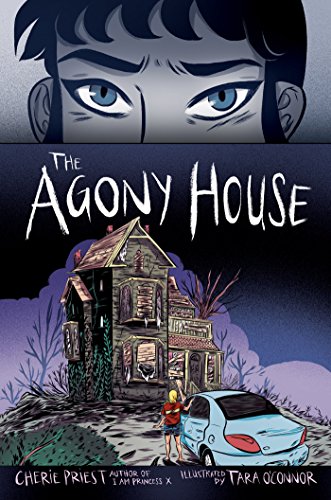
![]() The Agony House by Cherie Priest
The Agony House by Cherie Priest
When she was too young to remember, Denise Farber’s father and grandmother died in New Orleans during Hurricane Katrina. She and her mother fled to Houston. Now, with Denise about to enter her senior year in high school, her mother has just remarried and their new little family is returning to New Orleans. They have very little money, so they’ve purchased an old dilapidated Victorian style home that they hope to fix up and turn into a Bed & Breakfast.
After moving into the house, which has been nicknamed “The Nail House” by the neighbors, conditions are far worse than they imagined. Almost nothing works, new electrical wiring and plumbing is required, all of the walls and flooring need remodeling, and the place is filthy. As they start working on the house, strange things start happening — Denise sees, hears, smells, and feels things that don’t seem to exist and then there are multiple dangerous accidents. The house, which seems to be haunted, is both a money trap and a death trap.
With the help of a boy who’s curious about the house, Denise discovers an old comic book in the attic. As the teens read the comic and investigate its author, a reclusive man who lived around the time that the Comics Code Authority was formed, they begin to unravel the mysteries of what Denise calls “The Agony House.”
 The Agony House (2018), which is a finalist for this year’s Locus Award for Best Young Adult Novel, is a fun young adult paranormal mystery with a bonus. It contains a comic book within the story. The ebook version includes lovely black, white, and blue artwork by Tara O’Connor. The audio version, which I also read and which is produced by Scholastic Audio, doesn’t have the artwork, of course, but still manages to attain a comic book feel in those sections by including background sound effects and a full cast of narrators. It is surprisingly effective and I didn’t feel like I was missing the art (though I’m glad I took a look at it with the ebook version).
The Agony House (2018), which is a finalist for this year’s Locus Award for Best Young Adult Novel, is a fun young adult paranormal mystery with a bonus. It contains a comic book within the story. The ebook version includes lovely black, white, and blue artwork by Tara O’Connor. The audio version, which I also read and which is produced by Scholastic Audio, doesn’t have the artwork, of course, but still manages to attain a comic book feel in those sections by including background sound effects and a full cast of narrators. It is surprisingly effective and I didn’t feel like I was missing the art (though I’m glad I took a look at it with the ebook version).
Cherie Priest deepens the story by touching on a couple of important historical events, as well as some recent economic and social topics. One is, of course, Hurricane Katrina and the devastating effects it had on the geography and economy of New Orleans as well as the personal devastation it brought to families that lived through it. Another is the Comics Code Authority which censured comics from the 1950s until 2011 and insured that gender roles in comics conformed with conservative family values.
Other major themes in The Agony House are poverty, race relations, and gentrification. It’s refreshingly realistic to watch Denise and her family deal with their poverty. They are a white family who’ve moved into a big house in a predominantly black neighborhood. Denise has trouble fitting in at first, especially because the black teens assume her family is there to start the gentrification process. The kids’ discussion of what this means for the neighborhood and the families who live there may be eye-opening for many young adult readers.
I enjoyed The Agony House and recommend either the print or audiobook version to kids and adults of any age. It’s clean, entertaining, and instructive.



I’ll have to get this one! Priest does great haunted house books.
Seconded!
your review entices me more than other things I’ve read on this